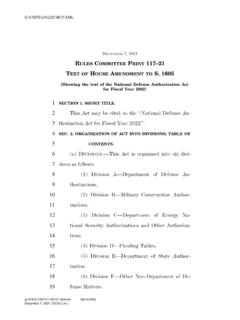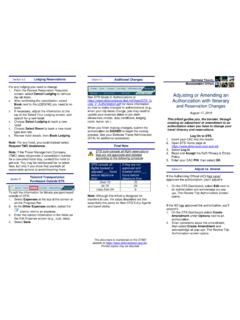Transcription of Instances of Use of United States Armed Forces Abroad ...
1 Instances of Use of United States Armed Forces Abroad , 1798-2021 Updated September 8, 2021 Congressional Research Service R42738 Congressional Research Service SUMMARY Instances of Use of United States Armed Forces Abroad , 1798-2021 This report lists hundreds of Instances in which the United States has used its Armed Forces Abroad in situations of military conflict or potential conflict or for other than normal peacetime purposes. It was compiled in part from various older lists and is intended primarily to provide a rough survey of past military ventures Abroad , without reference to the magnitude of the given instance noted. The listing often contains references, especially from 1980 forward, to continuing military deployments, especially military participation in multinational operations associated with NATO or the United Nations. Most of these post-1980 Instances are summaries based on presidential reports to Congress related to the War Powers Resolution. A comprehensive commentary regarding any of the Instances listed is not undertaken here.
2 The Instances differ greatly in number of Forces , purpose, extent of hostilities, and legal authorization. Eleven times in its history, the United States has formally declared war against foreign nations. These 11 war declarations encompassed five separate wars: the war with Great Britain declared in 1812; the war with Mexico declared in 1846; the war with Spain declared in 1898; the First World War, during which the United States declared war with Germany and with Austria-Hungary during 1917; and World War II, during which the United States declared war against Japan, Germany, and Italy in 1941, and against Bulgaria, Hungary, and Rumania in 1942. Some of the Instances were extended military engagements that might be considered undeclared wars. These include the Undeclared Naval War with France from 1798 to 1800; the First Barbary War from 1801 to 1805; the Second Barbary War of 1815; the Korean War of 1950-1953; the Vietnam War from 1964 to 1973; the Persian Gulf War of 1991; global actions against foreign terrorists after the September 11, 2001, attacks on the United States ; and the war with Iraq in 2003.
3 With the exception of the Korean War, all of these conflicts received congressional authorization in some form short of a formal declaration of war. Other, more recent Instances have often involved deployment of military Forces as part of a multinational operation associated with NATO or the United Nations. The majority of the Instances listed prior to World War II were brief Marine Corps or Navy actions to protect citizens or promote interests. A number were engagements against pirates or bandits. Covert operations, domestic disaster relief, and routine alliance stationing and training exercises are not included here, nor are the Civil and Revolutionary Wars and the continual use of military units in the exploration, settlement, and pacification of the western part of the United States . For additional information, see CRS Report RL31133, Declarations of War and Authorizations for the Use of military force : Historical Background and Legal Implications, by Jennifer K.
4 Elsea and Matthew C. Weed, CRS Report R42699, The War Powers Resolution: Concepts and Practice, by Matthew C. Weed; and CRS In Focus IF10539, Defense Primer: Legal Authorities for the Use of military Forces , by Jennifer K. Elsea, CRS In Focus IF10535, Defense Primer: Congress s Constitutional Authority with Regard to the Armed Forces , by Jennifer K. Elsea, and CRS In Focus IF10534, Defense Primer: President s Constitutional Authority with Regard to the Armed Forces , by Jennifer K. Elsea. R42738 September 8, 2021 Barbara Salazar Torreon Senior Research Librarian Sofia Plagakis Research Librarian Instances of Use of United States Armed Forces Abroad , 1798-2021 Congressional Research Service Contents Introduction .. 1 Listing of Notable Deployments of military Forces Overseas, 1798-August 2021 .. 2 Related CRS Products .. 51 Sources .. 51 Contacts Author Information .. 52 Instances of Use of United States Armed Forces Abroad , 1798-2021 Congressional Research Service 1 Introduction The following list reviews hundreds of Instances in which the United States has used military Forces Abroad in situations of military conflict or potential conflict to protect citizens or promote interests.
5 The list does not include covert actions or numerous occurrences in which Forces have been stationed Abroad since World War II in occupation Forces or for participation in mutual security organizations, base agreements, or routine military assistance or training operations. Because of differing judgments over the actions to be included, other lists may include more or fewer These cases vary greatly in size of operation, legal authorization, and significance. The number of troops involved ranges from a few sailors or marines landed to protect American lives and property to hundreds of thousands in Korea and Vietnam and millions in World War II. Some actions were of short duration, and some lasted a number of years. In some examples, a military officer acted without authorization; some actions were conducted solely under the President s powers as Chief Executive or Commander in Chief; other Instances were authorized by Congress in some fashion. In 11 separate cases (listed in bold-face type) the United States formally declared war against foreign nations.
6 For most of the Instances listed, however, the status of the action under domestic or international law has not been addressed. Most occurrences listed since 1980 are summaries of military deployments reported to Congress by the President as a result of the War Powers Resolution. Several of these presidential reports are summaries of activities related to an ongoing operation previously reported. Note that inclusion in this list does not connote either legality or level of significance of the instance described. This report covers uses of military force Abroad from 1798 to August 31, 2021. It will be revised as circumstances warrant. 1 Other lists include Sen. Barry Goldwater, War without Declaration: A Chronological List of 199 military Hostilities Abroad without a Declaration of War. 1798-1972, Congressional Record, vol. 119, July 20, 1973: S14174-S14183; Department of State, Armed Actions Taken by the United States Without a Declaration of War, 1789-1967, Research Project 806A, Historical Studies Division, Bureau of Public Affairs; John M.
7 Collins, America s Small Wars (New York: Brassey s, 1991). For a discussion of the evolution of lists of military actions and legal authorization for various actions, see Francis D. Wormuth and Edwin B. Firmage, To Chain the Dog of War; the War Power of Congress in History and Law (Dallas: Southern Methodist University Press, 1986), pp. 133-149. Instances of Use of United States Armed Forces Abroad , 1798-2021 Congressional Research Service 2 Listing of Notable Deployments of military Forces Overseas, 1798-August 2021 1798-1800 Undeclared Naval War with France. This contest included land actions, such as that in the Dominican Republic, city of Puerto Plata, where marines captured a French privateer under the guns of the forts. Congress authorized military action through a series of statutes. 1801-1805 Tripoli. The First Barbary War included the USS George Washington and Philadelphia affairs and the Eaton expedition, during which a few marines landed with United States Agent William Eaton to raise a force against Tripoli in an effort to free the crew of the Philadelphia.
8 Tripoli declared war on the United States on May 10, 1801, and although Congress authorized military action by statute, they never voted on a formal declaration of war. 1806 Mexico (Spanish territory). Captain Z. M. Pike, with a platoon of troops, invaded Spanish territory at the headwaters of the Rio Grande on orders from General James Wilkinson. He was made prisoner without resistance at a fort he constructed in present-day Colorado, taken to Mexico, and later released after seizure of his papers. 1806-1810 Gulf of Mexico. American gunboats operated from New Orleans against Spanish and French privateers off the Mississippi Delta, chiefly under Captain John Shaw and Master Commandant David Porter. 1810 West Florida (Spanish territory). Governor William Charles Cole Claiborne of Louisiana, on orders of the President, occupied with troops territory in dispute east of the Mississippi River as far as the Pearl River, later the eastern boundary of Louisiana. He was authorized to seize as far east as the Perdido River.
9 1812 Amelia Island and other parts of east Florida, then under Spain. Temporary possession was authorized by President Madison and by Congress, to prevent occupation by any other power; but possession was obtained by General George Matthews in so irregular a manner that his measures were disavowed by the President. 1812-1815 War of 1812. On June 18, 1812, the United States declared war between the United States and the United Kingdom of Great Britain and Ireland. Among the issues leading to the war were British interception of neutral ships and blockades of the United States during British hostilities with France. 1813 West Florida (Spanish territory). On authority given by Congress, General Wilkinson seized Mobile Bay in April with 600 soldiers. A small Spanish garrison gave way. The United States advanced into disputed territory to the Perdido River, as projected in 1810. No fighting. 1813-1814 Marquesas Islands. Forces built a fort on the Pacific island of Nuku Hiva, the largest of the Marquesas, to protect three prize ships which had been captured from the British.
10 1814 Spanish Florida. General Andrew Jackson took Pensacola Bay and drove out the British, in September 1814 with whom the United States was at war and pacified the Spanish governor of Florida. This capture of Pensacola was crucial to Jackson securing victory during the battle of New Orleans in November 1814. 1814-1825 Caribbean. Engagements between pirates and American ships or squadrons took place repeatedly, especially ashore and offshore about Cuba, Puerto Rico, Santo Domingo, and Yucatan. Three thousand pirate attacks on merchantmen were reported between 1815 and 1823. In 1822, Commodore James Biddle deployed a squadron of two frigates, four sloops of war, two brigs, four schooners, and two gunboats in the West Indies. 1815 Algiers. The second Barbary War was declared against the United States by the Bey of Algiers of the Barbary States , an act not reciprocated by the United States . Congress did authorize a military expedition by statutes. A large fleet under Commodore Stephen Decatur attacked Algiers and obtained indemnities.
















